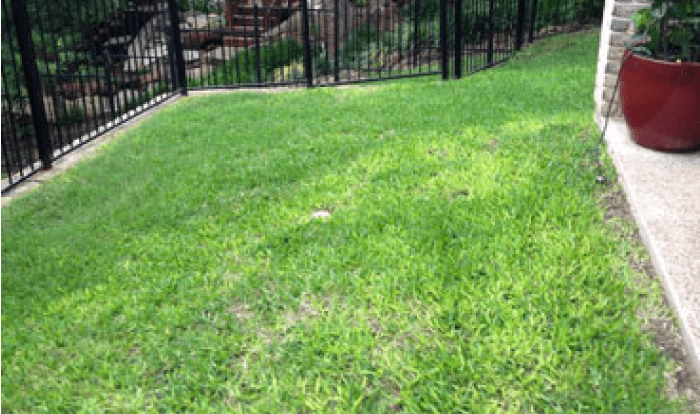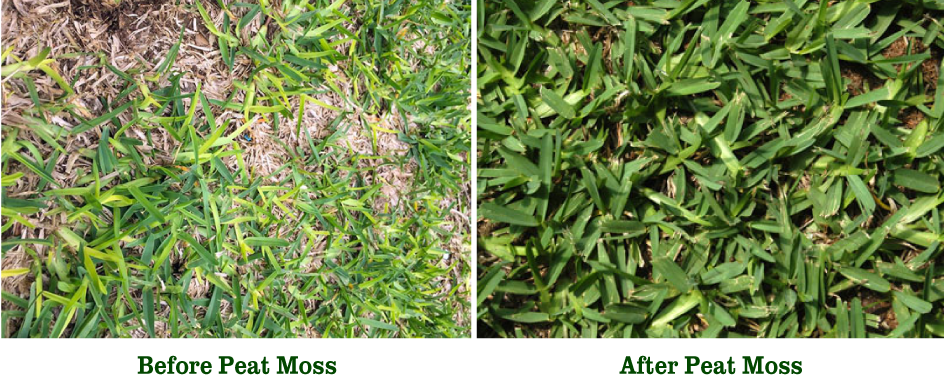Dead patches in your grass? James shares tips on plugging damaged lawn areas with Floratam Sod.
plugging
Take-All Root Rot (TARR), or Take-All Patch, is a serious fungal disease affecting St. Augustine and Bermuda grass lawns in the Coastal Bend. I have diagnosed 4 cases in the last 7 days, with lawn damage ranging from a few small dead spots up to an 80% dead lawn overrun by weeds, which last year was a great source of pride to the now-dismayed owner.

High soil pH, soil compaction, too much or too little fertilizer, too much or too little irrigation, or herbicide injury are all stress factors that can make lawns more susceptible to TARR. TARR is related to but different from Large Patch (Brown Patch), which we commonly see in Fall and Winter. Large Patch results in temporary brown roughly circular patches during Winter but the lawn revives in Spring, whereas TARR kills roots and runners completely and the lawn will not recover on its own.

TARR, like Large Patch, can be spread by mowers, foot traffic, birds, and wind. TARR cannot be cured or eliminated, but it can be suppressed by cultural practices or by fungicide use. We prefer to treat organically by spreading one 3.8 cubic foot bale of Canadian peat moss over 1000 square feet of lawn in October or November, followed in March by Natures Blend compost at one bag per 50 square feet of lawn. We have had good results in restoring lawns with this method. Or you can choose to apply Fertilome F-Stop fungicide granules in October, November, December, and January, once a month. For patches 3 feet across or more, I recommend plugging Floratam St. Augustine into the dead areas, with a little Natures Blend compost beneath and on top.
First visual symptoms of TARR are yellow patches or strips, followed by thinning brown patches of lawn with a few unhealthy tufts of green, showing some dead brown runners and darkened, weak, unhealthy roots. Confirmation of TARR requires a microscope to observe a network of black filaments running over the surface of infected stolons (runners). Bring in a sample of diseased but still living runners (not completely brown and dead), and we can advise you on best cultural practices to have the best lawn possible.

– James Gill
Spring is in full swing and everyone is ready to get their lawn and landscape in shape for the season. Take these 3 steps to healthy grass that looks and feels great.
Remember – a healthy lawn keeps weeds and disease away. If you are having a problem with either, we can help! Bring us a sample of your grass, and we’ll diagnose and supply the best solution.
- Wait for the right time to fertilize. Grass has just started to come out of Winter dormancy, and as we continue to get warmer, it will grow quicker. Once you are mowing your lawn once a week, you know it’s time to fertilize – wait until then! If you fertilize too early, before the grass is actively growing, the fertilizer will not be able to do its best work. We recommend using organic Medina Growin’ Green or our Gill Food. Feeding your lawn at the right time will give it the nutrients it needs to thrive through our Summer until we fertilize again in the Fall.
- Water thoroughly, not frequently. As we start to warm up, lawns need to be watered once a week with one inch of water. You should maintain this watering now through the Summer. It’s always better to water thoroughly not frequently in order to maintain adequate soil moisture. If you find water running off into the gutter before you get one inch, you need to break your watering into two or three applications on the same day (Cycle Soak Method of Lawn Irrigation). The second and third watering will push the water down deeper into the soil, to help grow a deeper root system.
- Pro tip: Use the Tuna Can Test. Place an empty tuna or cat food can in the area where you are watering, or where your sprinkler is watering. Water the area until the can fills up with 1” of water, and you’ll know you’ve watered thoroughly.
- Nature’s Blend: your lawn’s best friend. If you have dead or thin areas in your lawn, now is the time to fix them. Begin with raking out the dead grass in those spots, then spread a thin layer of Nature’s Blend compost across the dirt (about a quarter inch thick). The organic material will encourage new runners in those areas so they can start to grow and fill in. For any dead area 3ft. wide or greater, we recommend plugging in small pieces of sod. If the majority of the lawn is dead, it’s probably time to till, regrade, and re-sod.
- Pro tip: You can spread Nature’s Blend on your lawn 2-3 times a year to enhance your soil structure and prevent Take All Root Rot.
We’re so happy with the results we’ve seen from spreading Nature’s Blend that Gill’s is now offering this service! Give us a call if you’re interested in having us come out with our compost spreader and do the work for you.

– Wyatt

